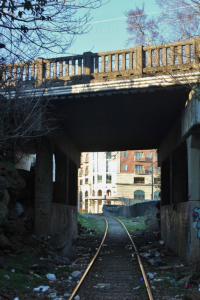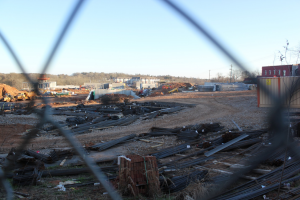Examining economic growth and conflicting narratives in Athens
By Caskey Dyer
This article originally appeared as the cover story of the Spring 2016 GPR Magazine.
My roommate and I walked through the doors of the Standard as the sun was setting. The manager agreed to us taking pictures, and passed us off to one of the student employees for a tour. We were led through a five-star common room; a rec room with pool tables and a flat-screen; a golf simulator; and an enclosed courtyard with two grills, a fountain, and fake grass. Students usually get this tour with their parents in tow – lacking those, my roommate and I probably received less schmooze.
Despite its name, the Standard’s design screams exceptionality, particularly when contrasted with the average Athens household. On a larger scale, the name becomes less of an oxymoron: “Standards” exist at the Universities of Florida, Appalachian State, Tennessee, Baton Rouge, and California-Berkeley. They’re operated by Landmark Properties, the real estate firm that also manages “the Retreat” northeast of downtown (“Retreats,” ironically, exist across the entire country). Landmark does not, however, own the Standard. They sold to the American Campus Corporation, one of three large Real Estate Investment Trusts (or REITs) that dominate the market on upscale student housing. REITS are like mutual funds – they own or finance real estate that generates income for shareholders. The boom in luxury student housing really began about twenty years ago. Now, these projects are listed on some of the biggest balance sheets in the country – investment firm giants like the Vanguard Group are their top owners.
At the Standard, the employee led us to the rooftop infinity pool. Sunlight bathed everything in orange, casted long shadows behind pool chairs and sparkled blindingly on the clear surface of the pool. I crossed to “infinity” edge and stared down at the roofs of Whistlebury (another student housing complex). By the elevators, my roommate and the employee looked out over the rooftops of downtown.
“I never knew Athens had a skyline,” the employee said. “But here it is, it’s beautiful.”

“Downtown is a student district,” explained Dr. Hilda Kurtz. Dr. Kurtz is a professor in the Geography Department at UGA (I’d taken her Urban Geography course my sophomore year). “We call it downtown as a residual. It has seats of government, it has some of the central administrative functions of a downtown, but functionally? It’s a student town.”
It’s easy to see what she means. Wind your way up from Broad to Dougherty, and you’ll pass block after block of restaurants, bars, concert venues, and boutiques. There are a few exceptions, of course, like Horton’s Drug Store and the CVS. But the majority of businesses downtown are shaped by two important consumer bases: students armed with, as Dr. Kurtz calls it, “non-trivial amount of disposable income”; and the townies, the young-adult locals, primarily non-students, who dominate the established music scene.
Downtown wasn’t always this homogenous. Prior to the 1980s, it hosted shops for groceries and appliances, movie theaters, and even a car dealership. There were still bars and concert venues, but these were amongst a wide variety of other goods and services. If you weren’t as affluent as some of the students, you could still walk or catch a bus downtown and buy things for your family and home. This portrait matches our traditional idea of what a “downtown” is: a central hub of economic and social activity where a variety of needs are met.
Things began to change in the early 1980s, when the Georgia Square Mall opened on Atlanta Highway. Locally-owned downtown businesses either moved voluntarily or were bought up by larger retail chains. For a brief period of time, downtown Athens was, according to Chamber of Commerce President Doc Eldridge, a “ghost town.” Shortly afterwards, a “nighttime economy” filled the void, and the explosion of bars and venues in the 1980s brought Athens national recognition as a small college town with a whole lot of quirk.

Students got an extra boost in 1993, when Georgia established the HOPE scholarship. What originated as an attempt to stem the state’s brain drain ended up freeing up a lot of savings for middle- and upper-class families with children, which drove up the demand for higher-quality student housing. Students who could afford to upgrade moved closer to nicer locations closer to Downtown. Boutiques and restaurants flourished. Though many rarely stayed in business for more than a few years, building improvements and increased foot traffic became attractive qualities for investors, and rarely was a space empty for long. Now, while places like the Standard and Urban Outfitters may seem to stand out, it’s unknown how significant they’ll be in the long-term.
So it’s undeniable Downtown’s good for businesses – and for the county’s tax base. The Walker’s regulars I spoke to weren’t worried about the higher-end locations. “Athens is cyclical,” they argued, “and it always keeps its character.” Doc Eldridge was also optimistic. “It’s a welcome addition. Is it competition for local business owners? Of course. It’s good for everybody.”
You hear this narrative often – new business is good business, and expensive business is even better. We all stand to benefit from the increase in competition and tax revenues. But it’s just as obvious that not all growth benefits everyone equitably. As GPR’s own Eli Scott pointed out, Athens is still one of the poorest counties of its size in the country. Take an Athens Transit bus down Oglethorpe, and you’ll pass by miles of marginalized communities – largely low-income, largely African American and Latino. Despite the growth Downtown being good for “everyone,” it’s difficult to imagine these communities benefitting much from a new J. Crew opening up – even with marginal increases to the tax base.
The housing situation isn’t improving much, either. A study commissioned by the ACC government found that “workforce housing” – housing for families making between 60 and 120 percent of the area median income – is getting harder to come by. The low-density, single-family housing that these families want just isn’t being built here. Affordable rental housing’s getting rarer as well. In the past decade, 67 percent of the rental housing built was intended for students, and only 11 percent for low-income families.
Even public housing tenants are feeling the pressure. As Marina Applegate of the Athens Housing Authority told me, legislation from the Department of Housing and Urban Development tied public housing rents to market rates – meaning occupants had to start paying a couple hundred dollars more for the same run-down housing. The remaining affordable housing is located in places like the Eastside, where poverty abounds and many units aren’t even fit for occupancy.
The point here isn’t that this inequality is a new, frightening thing. What’s worrisome is that we’ve allowed our narrative of “what’s good for Athens” to subtly exclude a whole lot of Athenians. The city has a reputation for being hip, progressive, and inclusive. But the kinds of policies that would really integrate disparate Athenians – like an inclusionary zoning ordinance or infill development for affordable housing – aren’t likely to be passed without, as Link argues, widespread public shaming.

The spatial seclusion of low-income neighborhoods helps us put them out of mind.The average UGA student may pass by the low-income housing on Broad St. daily, but it’s easy to avert our eyes during those few uncomfortable seconds when socioeconomic injustice is staring us in the face. It would be harder to ignore Athens’ inequality were we passing through neighborhoods like Pine Wood or Tallassee Club on the daily.
During research for this article, I came across an interesting essay by David Harvey called “The Right to the City.” Dr. Harvey is an English scholar of geography and anthropology who writes extensively on capitalism’ effect on cities. As Harvey argues, cities are unique for their concentrations of surplus capital investments. As space runs out, the old must often be torn down to make way for the new, a process which hurts the poor first, and hardest. As capital globalizes, and financial institutions grow and evolve, the owners of these projects – the ones deciding the physical landscape of cities – are increasingly removed from their streets. This poses a real threat to the citizens’ “right to the city” – the right, Harvey argues, to ultimately shape our landscape and shape ourselves. Regardless of if we’re here for four years or for the rest of our lives, our consumption choices will have a very real impact on Athens’ cityscape. If we want to keep thinking of ourselves as uniquely inclusive space, it’s time to start pushing for real, inclusionary policies to make that happen.
